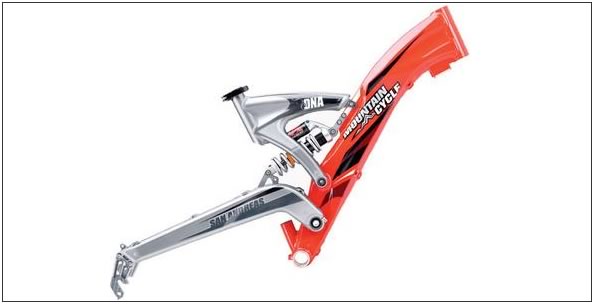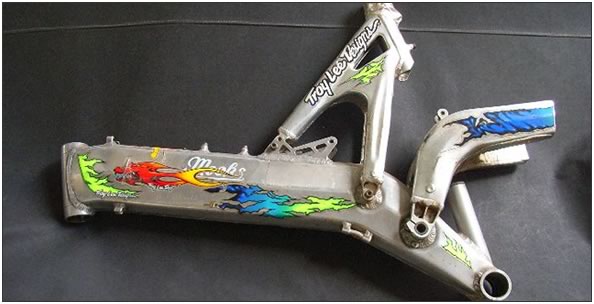Old dog, new tricks?
Published:
Updated:
September 20, 2009
May 23, 2024
Update 18 Jan, ’22:
I’ve finally written the follow-up to this article – read the latest installment here.

Back in 1989 or so, a chappy by the name of Robert Reisinger (now a Mountain Bike Hall of Fame inductee) designed a frame for his small newly formed company, Mountain Cycle. The frame was called the San Andreas and was the first true mountain bike full suspension frame. With a solid background in designing MX machines for the likes of Kawasaki, Reisinger applied a thinking to his design, that up until then (and even now to some extent), was foreign to the bike world.

The basis for the design was simple enough, anyone who has had anything to do with motorcycles will understand it. The role of a frame, or chassis, is to connect the head tube to the rear wheel in the stiffest possible manner. On a bicycle you have to throw the bottom bracket into that, through which an unbalanced power delivery is clipped in (that’s YOU BTW). For a loooong time the only, and best, way to do that was with what is called a double triangle design, a.k. the everyday bike frame. This design is strength and simplicity at its best and allows for weights to be as low as possible and yet stay very strong. Through careful tube selection, a good builder can fine tune the frame for a light, smooth, silky ride.
The wobble comes when suddenly the rear wheel is suspended and needs to move. Throwing suspension into the equation suddenly means that fine tuning the frame is far less important, as the suspension now handles a lot of what was trying to be done with a rigid structure – take out fatigue inducing bumps and frequencies. Reisinger solved this problem by throwing away the tried and tested double triangle, and tubes for that matter, and connected the lot through a pressed monocoque frame. Doing this allowed the frame to be engineered for tortional rigidity, have a wide, thus stiff, single pivot point for the swing arm and connect the head tube to the bottom bracket in one ‘single’ piece. For the rear end, and right out of the moto world, a monocoque style swing arm swept up and over the cranks, thus allowing for a short chainstay length, attaching the rear wheel to the frame in the simplest, and stiffest, manner possible. As an upside, it also allowed a direct and very simple connection of the shock to the frame. Stripped, the San Andreas could be a frame for a small motorcycle.
[shop_bike]
The end result of this was a frame that unlike any before it, and many after, was insanely stiff, strong, highly responsive and light. When you think that Reisinger then attached his own ‘Pro Stop’ disc brakes (with floating rotor) and upside down forks, you can see that even now, let alone 1991 when he debut the frame at Interbike, the Mountain Cycle San Andreas really was a piece of mountain biking design brilliance.
Today, the San Andreas still manages to turn heads in amongst the river of designs that it inspired, yet none have endured in the way that it has, 20 years on. If it were a car or a motorcycle, it would be considered a classic and while one will find the bike in the Museum of Contemporary Art in San Francisco, not many realise that there are people out there who either are looking for or are still running San Andreas frames in various incarnations; it’s rare to find a rider who had one and moved it on not later regret the decision. The bike has a mystic appeal and once you get used to its personality, you won’t want to part with it.
Personally I have had three San Andreas’ over the years. In 1993 I bought my first, which had the 2″ travel elastomer rear shock and 1 1/4″ headset. It was one of the first of the production bikes to come out of the California based Mountain Cycle. I’ll never forget my first ride on it, equipped with canti brakes and down steep fire trails that I knew so well on my steel GT. The bike picked up so much speed and was so direct in its response that, cutting the lines I took with the GT, got me into increasingly larger amounts of trouble until I had to stop, shaking. Welcome to the brave new world. I rode that bike over everything, from fire trails to steep goat track climbs up the sides of mountains, to me it defined what a mountain bike should be.

San Andreas ‘DNA’. Designed by Kenisis, it had (has) it’s issues and did the original no favours…
In ’96 I let the frame go and moved to all sorts of other bikes until in ’05, I bought another, after the custom bike I had waited months for to arrive turned out to be a total dud and was promptly sent back. The second San Andreas was from the ‘new’ Mountain Cycle, owned by Kinesis and I bought it just as Mountain Cycle was closing its doors. The ‘Classic’, as it was then being called, had a few refinements but by in large it was the same frame as my ’93 model. More travel, which yielded a skyscraper of a bottom bracket and with the VPS shock/head angle adjustment system, this was what ended up being the final production frame. As a quick side note, Kinesis also made a new San Andreas it called the ‘DNA’… which ended up being a marketing disaster – it was a XC and light AM design being pushed to Free Ride and DH. Net result? The DNA broke…. lots. Anyway, I threw a Rholoff and a Pushed Fox shock on my ‘Classic’ and it once again became the ultimate trail bike – simple and almost maintenance free. Several years later though it was stolen from my garage and yes, I was truly pissed off as Mountain Cycle had since vanished from the scene and after nearly 20 years, the San Andreas was no longer in production.

In late ’07 I managed, by sheer fluke, to find an old 2000 San Andreas front end at local legend repair shop [Gripsport.com.au] and had mated it to the spare ’03 rear end I had laying around (don’t ask); the rear end from the old frame was snapped clean in half. The chop job was perfect though and one would never know, unless they were well versed in the various incarnations of the frame. The older frame lacked the VPS system, which to me was a good thing as Kinisis did a bang-up job in crap engineering, which saw many of the machined VPS blocks peel off the frame along with the seat towers. Mine did. Fifteen years on I was once again back on board what I still consider one of the best MTB frames ever made.
The question though is ‘does the old school set up cope with the added travel and new school kit hanging from it?’ In Robert Reisinger’s words:
“… the original SA was designed with 2″ travel front and rear, but as travel grew so did the acceptable BB heights over the years and the SA’s original frame was modified to provide more travel with a higher BB too. However, as it got higher, it became more of a design issue that we addressed in different ways over the years, however a new re-design of the frame was always on the books to do but never found the time. That being said, as components changed too, with smaller chain rings, it made the problems of performance even worse, so we started to incorporate the changes into the new frames.
The SA, in my opinion, needs a re-design… ”
g

Note:
It should be known that G does work for Mountain Cycle in the role of design director. That said, the above article reflects what has been a long time relationship with the San Andreas and indeed, the current version was assembled prior to signing on with Mountain Cycle. G’s opinion, as well as that of Mountain Cycle, is that the San Andreas can teach us all that design, when done well, does not age.
Gerard
I've sold titanium, designed and sold cycling rags, was co-conspirator for Australia's first major MTB website, run mtb events, designed bikes, and was a GM and head designer for a famous but sadly now extinct mtb bike marquee; and after 20 odd years I decided riding bikes was more fun than working with them.
Today I pedal (boom-tish!) cycling t-shirts